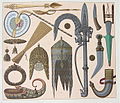Ficheiro:Racinet2.jpg
Racinet2.jpg (691 × 594 píxeis, tamanho: 120 kB, tipo MIME: image/jpeg)
|
|
Esta imagem provém do Wikimedia Commons, um acervo de conteúdo livre da Wikimedia Foundation que pode ser utilizado por outros projetos.
|
Descrição do ficheiro
| Artista |
ALBERT RACINET, Paris |
| Descrição |
"India, that country full of luxurious vegetation, rich in natural products of every kind, with inexhaustible mines of precious metals and stones, displays her character of overflowing abundance and the fantastic spirit of her inhabitants also in the productions of her art. But notwithstanding her old and comparatively high civilization, a certain conservatism, extending for nearly a thousand years to the social and religious conditions and, institutions, exercised, as a matter of course, its unavoidable influence also on the artistic productions, especially when you look on the caste-like separation of the several trades. Only since the beginning of our century can we report new introductions in the Indian art. Being little conventional and flowing freely, Indian ornament - seems to have the greatest affinity with the Persian style. The surface decoration, never losing its specific character, mostly exhibits a very profuse richness of recurring motives, and a grand splendour of colouring which, far from harassing the eyes of the beholder, affords, on the contrary, a salutary repose to them. The outlines of the design, in which all modelling is avoided, are generally executed on light ground in deeper colours than the pattern itself, and on dark ground-in light colours. The Indians found their principal motives, as seems most likely, among their native plants, employing in the first place lotus, excellently drawn roses, pinks, granates, etc.; but most frequently, especially in modern productions, we meet with the palm-branch always-treated conventionally. Fig. 1 and 2. Wooden spoons from Calcutta used for cream, Fig. 3. Bengalese fan used in Indian homes. The handle is made of wood, the fan part of silk and satin. The first fans used in India were made of palm leaves. They were used against flies, also a tail of the yak (Tibetan steer)) was used for this purpose, Fig. 4. depicts a book made of elongated wooden tablets tied together with a wire, Figs. 5, 11, 12, 13, 14, 15, and 16. depict various buttons, brooches, buckles made of embossed and chiseled gold, embellished with various precious stones, diamonds and pearls, Fig. 6. Antique steel hook used by elephant riders, Fig. 7. Little knife from Nepal, Fig. 8. A khouttar, Indian dagger, distinguished by its sheath covered with velvet. This weapon is only known in Hindustan, Figs. 9 and 10. Another dagger with a bent-shaped blade, strengthened along its length with a raised rib. This type of dagger was not attached to a belt but was carried hanging from it, Fig. 17. Depicts a shoe of a nahab. The fabric is made of golden filaments, embroidered with silk and pearls, Fig. 18. A helmet of a mogul from the 16th Century, the top is highlighted by a pyramid-shaped button, the front has the nose protector." |
| Data |
1878 date QS:P571,+1878-00-00T00:00:00Z/9 |
| Fonte/Fotógrafo | http://www.columbia.edu/itc/mealac/pritchett/00routesdata/1700_1799/localrulers/weapons/xracinet.html |
Licenciamento
| Public domainPublic domainfalsefalse |
This work is in the public domain in France for one of the following reasons:
العربية ∙ English ∙ español ∙ français ∙ 日本語 ∙ 한국어 ∙ македонски ∙ русский ∙ Tiếng Việt ∙ 简体中文 ∙ 繁體中文 ∙ +/− |
 |
Histórico do ficheiro
Clique uma data e hora para ver o ficheiro tal como ele se encontrava nessa altura.
| Data e hora | Miniatura | Dimensões | Utilizador | Comentário | |
|---|---|---|---|---|---|
| atual | 12h16min de 23 de outubro de 2011 |  | 691 × 594 (120 kB) | Sridhar1000 | ............. |
| 04h51min de 30 de setembro de 2011 |  | 691 × 594 (120 kB) | Sridharbabu1000 |
Utilização local do ficheiro
A seguinte página usa este ficheiro:
Utilização global do ficheiro
As seguintes wikis usam este ficheiro:
- bn.wiki.x.io
- en.wiki.x.io
- hy.wiki.x.io
- it.wiki.x.io
- ms.wiki.x.io
- ru.wiki.x.io
- ta.wiki.x.io
- uk.wiki.x.io
Metadados
Este ficheiro contém informação adicional, provavelmente adicionada a partir da câmara digital ou scanner utilizada para criar ou digitalizar a imagem. Caso o ficheiro tenha sido modificado a partir do seu estado original, alguns detalhes poderão não refletir completamente as mudanças efetuadas.
| Fabricante da câmara | TOSHIBA |
|---|---|
| Modelo da câmara | PDRM81 |
| Tempo de exposição | 1/75 seg (0,013333333333333) |
| Número F | f/2,9 |
| Data e hora de geração de dados | 15h16min de 14 de maio de 2002 |
| Título | Sierra Exif JPEG |
| Orientação | Normal |
| Resolução horizontal | 72 ppp |
| Resolução vertical | 72 ppp |
| Software utilizado | Digital Camera PDRM81 Ver1.10 |
| Data e hora de modificação do ficheiro | 19h53min de 18 de junho de 2007 |
| Posicionamento Y e C | Co-localizadas |
| Programa de exposição | Programa normal |
| Taxa de velocidade ISO | 100 |
| Versão Exif | 2.1 |
| Data e hora de digitalização | 15h16min de 14 de maio de 2002 |
| Significado de cada componente |
|
| Velocidade do obturador | 6,2 |
| Abertura | 3,1 |
| Compensação da exposição | 0 |
| Abertura máxima | 3,1 APEX (f/2,93) |
| Modo de medição | Ponto |
| Fonte de luz | Desconhecida |
| Flash | Flash não disparou |
| Versão de Flashpix suportada | 1 |
| Espaço de cores | sRGB |
| Fonte do ficheiro | Câmara fotográfica digital |
